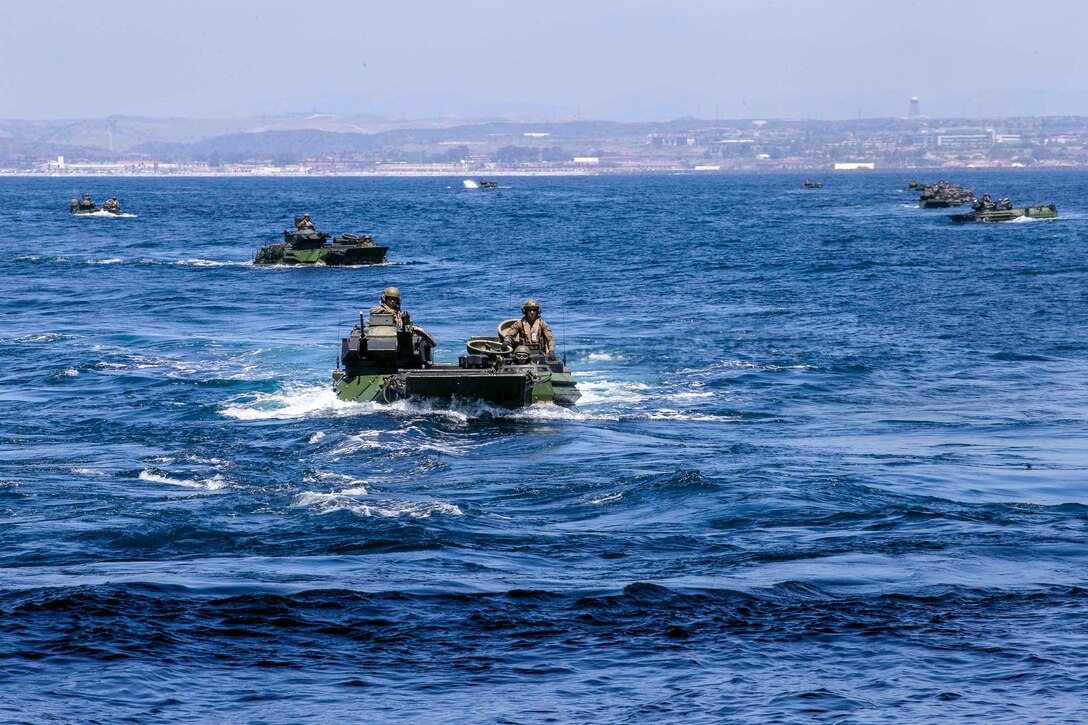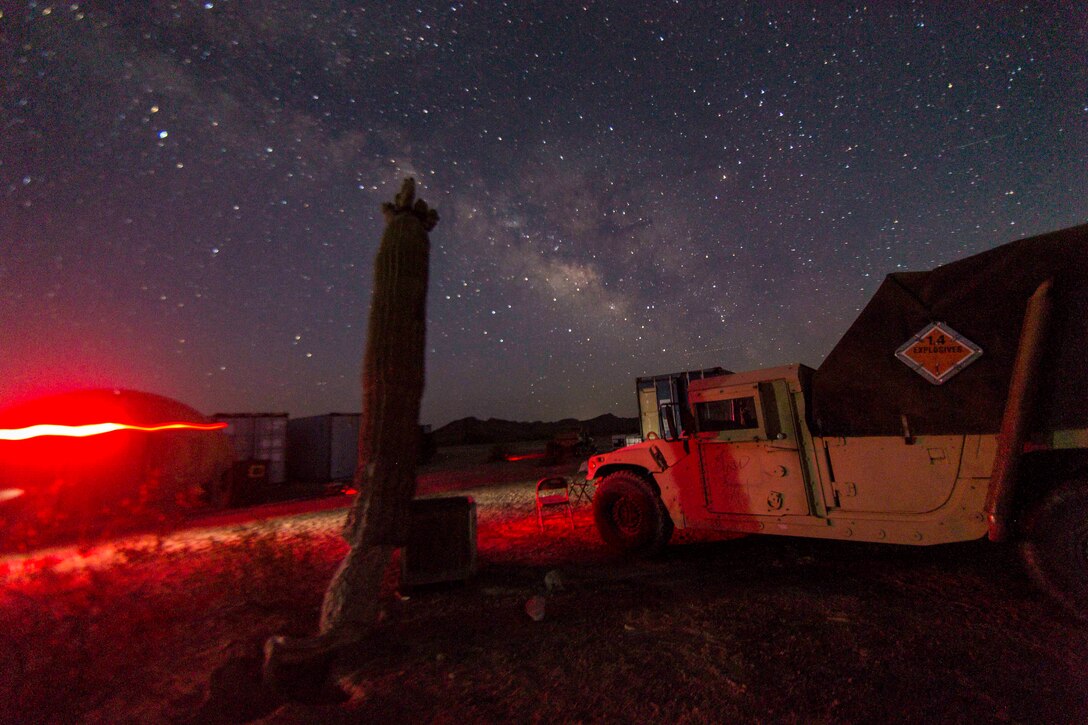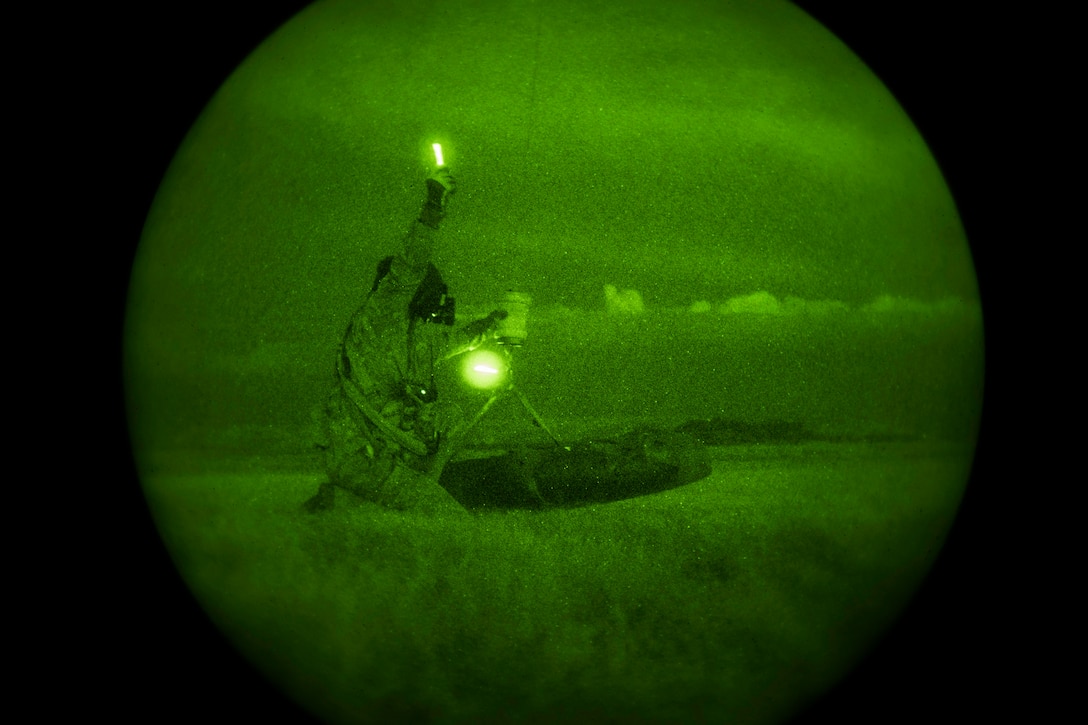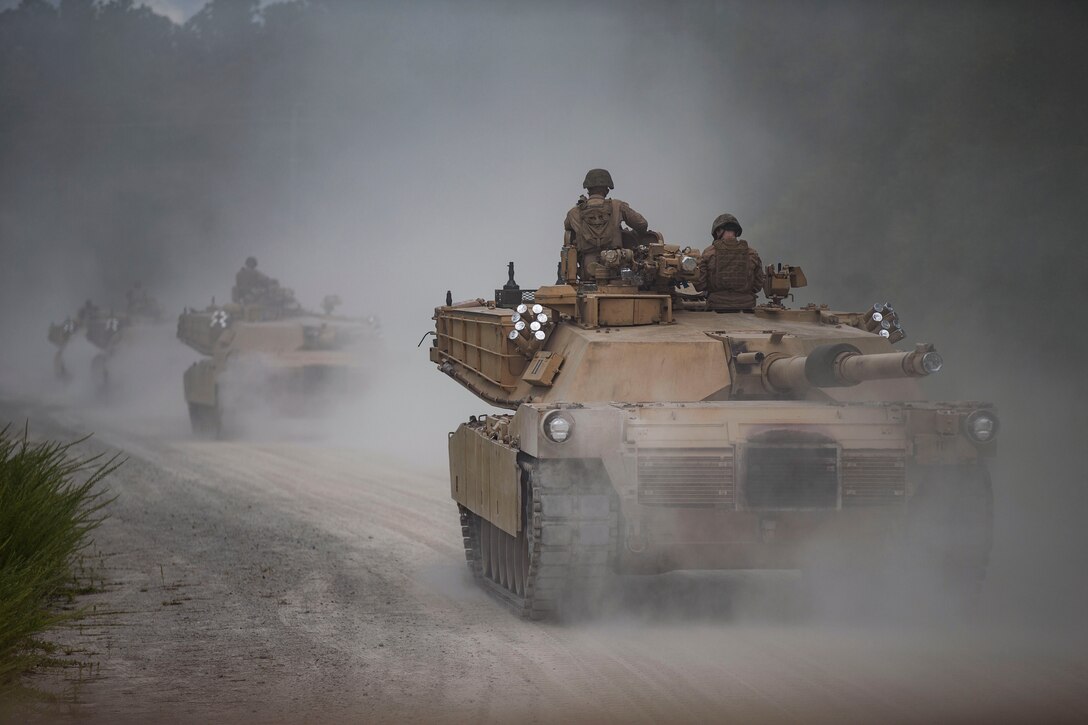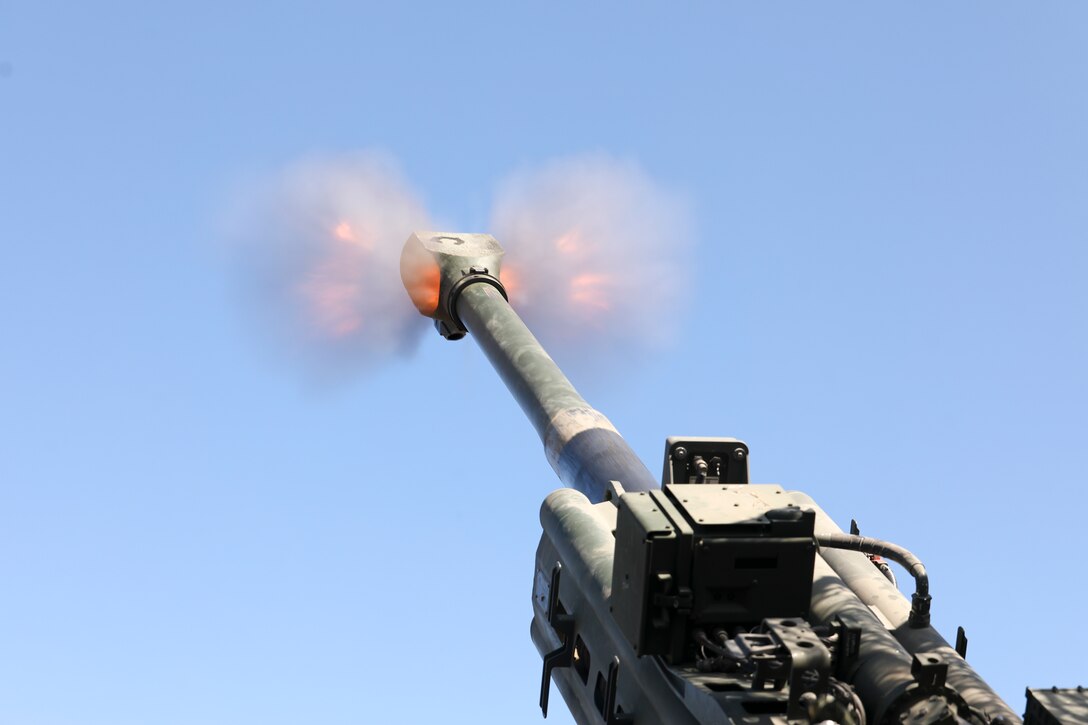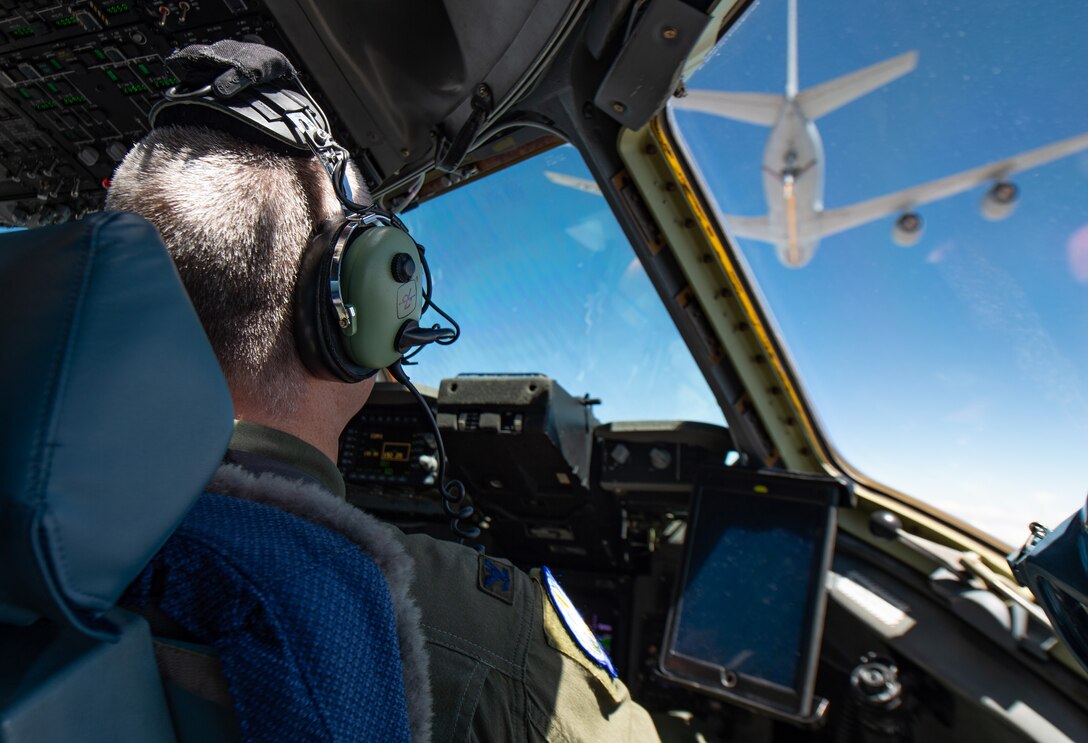Marines operate assault amphibious vehicles during training with the USS Somerset in the Pacific Ocean, July 27, 2020.
Providing up-to-date information, news and original content on American Military issues.
Wednesday, July 29, 2020
Base Ops
Marines conduct base operations at Yuma Proving Ground, Ariz., July 16, 2020, during Summer Fury, an exercise designed to enhance Marine Air-Ground Task Force integration and increase aviation operations proficiency.
Green Guard
An Idaho Army National Guardsman participates in night hoist rescue training with fellow guardsmen using night vision goggle equipment and UH-72 Lakota helicopters near Gowen Field in Boise, Idaho, July 21, 2020.
Final Ride
Marines assigned to the 2nd Tank Battalion track through tank trails for the last time at Camp Lejeune, N.C., July 27, 2020. After serving the 2nd Marine Division for more than 75 years, the battalion is slated to deactivate as part of a future redesign of the Marine Corps.
General Officer Announcements
Secretary of Defense Dr. Mark T. Esper announced today that the president has made the following nominations:
Air Force Maj. Gen. Nina M. Armagno for appointment to the rank of lieutenant general, with assignment as director of staff, Office of the Chief of Space Operations, Pentagon, Washington, D.C. Armagno is currently serving as director, space programs, Office of the Assistant Secretary of the Air Force (Acquisition, Technology and Logistics), Pentagon, Washington, D.C.
Air Force Maj. Gen. William J. Liquori Jr. for appointment to the rank of lieutenant general, with assignment as deputy chief of space operations for strategy, plans, programs, requirements and analysis, Office of the Chief of Space Operations, Pentagon, Washington, D.C. Liquori is currently serving as director, strategic requirements, architectures and analysis, Headquarters Air Force Space Command (redesignated U.S. Space Force), Peterson Air Force Base, Colorado.
Air Force Maj. Gen. Bradley C. Saltzman for appointment to the rank of lieutenant general, with assignment as deputy chief of space operations, operations, cyber, and nuclear, Office of the Chief of Space Operations, Pentagon, Washington, D.C. Saltzman is currently serving as deputy commander, U.S. Air Forces Central Command; and deputy commander, Combined Forces Air Component Command, U.S. Central Command, Al Udeid, Qatar.
Air Force Maj. Gen. Stephen N. Whiting for appointment to the rank of lieutenant general, with assignment as commander, Space Operations Command, Peterson Air Force Base, Colorado. Whiting is currently serving as deputy commander, Headquarters Air Force Space Command (redesignated U.S. Space Force), Peterson Air Force Base, Colorado.
General Officer Announcement
Secretary of Defense Dr. Mark T. Esper announced today that the president has made the following nomination:
Air Force Maj. Gen. Sam C. Barrett for appointment to the rank of lieutenant general, with assignment as director for logistics, J-4, Joint Staff, Pentagon, Washington, D.C. Barrett is currently serving as commander, Eighteenth Air Force, Air Mobility Command, Scott Air Force Base, Illinois.
DOD Must Do More to Prevent Sexual Assault
Nate Galbreath testified today before the House Armed Services Committee's military personnel subcommittee in a hearing called in the wake of Army Spc. Vanessa Guillen's death at Fort Hood, Texas. Guillen was found dead, and an investigation continues.
"Even with my 30 years investigating violent crime, supporting victims and counseling the wounded, nothing prepares one for something like this," Galbreath said. "The murder of Specialist Guillen has touched us all in some way, but no one feels the loss more than her family. I can only hope that the groundswell of support, love, compassion and even inspiration that comes … in Vanessa's name can bring some comfort for those who loved and knew her."

In Spanish, he added that no one should suffer as Guillen's family has suffered.
Although harassment-policy criminal investigation in the military justice system falls outside his portfolio, Galbreath said, SAPRO is keenly aware of how these issues play a critical role in their work to prevent and respond to sexual assault, and to allow those who choose to make a report to do so without fear of retaliation. While more work remains, many of SAPRO's efforts have resulted in certain progress, he said.
"As many of you know, the department has two key metrics in its sexual-assault program," he told the House panel. "First [is] estimated prevalence or how often crime occurs, which is the number we want to go down. Second, the number of reports [is what] we want to go up, which means that more victims are coming forward to connect with care and support services as well as [help] our efforts to hold offenders appropriately accountable," he explained.
Data shows that the estimated prevalence rates of sexual assault in DOD has decreased by over a third over the past 14 years, Galbreath said. "And reporting of sexual assault is four times what it was in 2006," he added.
However, DOD's most recent active-duty survey in 2018, showed an increase in the prevalence of sexual assault on women, he said. In addition, in that year, about 24% of women and 6% of men on active duty indicated experiencing behavior consistent with sexual harassment in the year before being surveyed.
Fear of retaliation complicates and degrades the department's efforts to encourage greater reporting of this conduct and to connect service members with restorative care, he emphasized.
"While not all behaviors perceived to be retaliatory by someone constitute retaliation that is actionable, all behaviors — actionable or not — gravely undermine our efforts in this space, and are incongruent with our expectations for dignity and respect," he said.
"To be blunt, such behaviors are absolutely unacceptable and have no place in a military that is striving for greater dignity, respect and inclusion for all," Galbreath said.
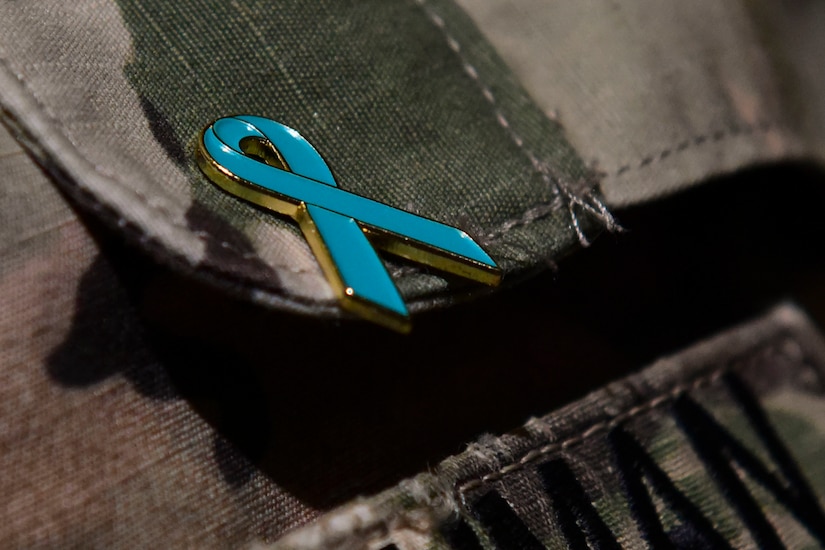
In some, achieving and sustaining progress requires continuous institutional examination, reflection and evolution, he said, adding that the Defense Department acknowledges the gap between where it is now and where it desires to be.
"We are committed to working toward lasting, impactful, cultural change," he said.
SAPRO establishes policy and conducts oversight on efforts to assist victims of sexual assault, encourage greater reporting, empower survivors to recover and prevent the crime.
Refueling Training
Air Force Col. Brian Collins flies a C-17 Globemaster III during an air refueling training sortie near Salt Lake City, Utah, July 27, 2020.
Nevada National Guard Helps Shoshone Tribe in Fight Against COVID-19
Nevada National Guardsmen with medical task forces 221 and 17 traveled north to assist the Shoshone Health District with COVID-19 community-based COVID-19 test collections in Duckwater, Nev.
According to Shoshone Health District records, their combined efforts July 1 resulted in testing 102 residents: 57% percent of the population and more than 80% of the active older adult population.
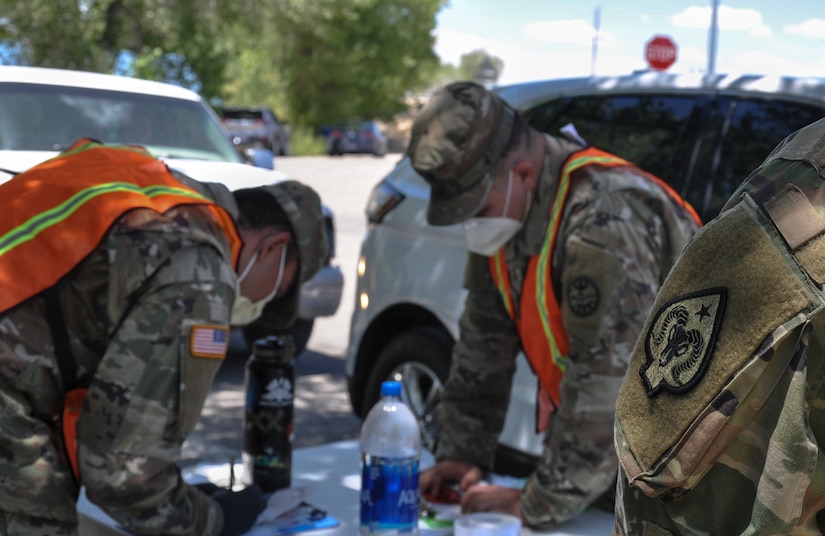
The Shoshone are a Native American tribe in eastern Nevada, where their people share a long and rich history. They are also known to be a part of the Great Basin American Indians, and at one point in history, the Shoshone tribes could be found stretching from central Wyoming to Texas, into California and up into parts of Canada. Although not known for their jewelry, Shoshone artists are famous for their beautiful beadwork, paintings, hides and woven baskets.
Army Staff Sgt. Keith Linford, with the Task Force Medical 17, discussed his take on the number of people tested within the timeframe. ''We tested over a hundred people in just four hours,'' he said. ''I think that's the largest number compared to all the other rural communities so far.''
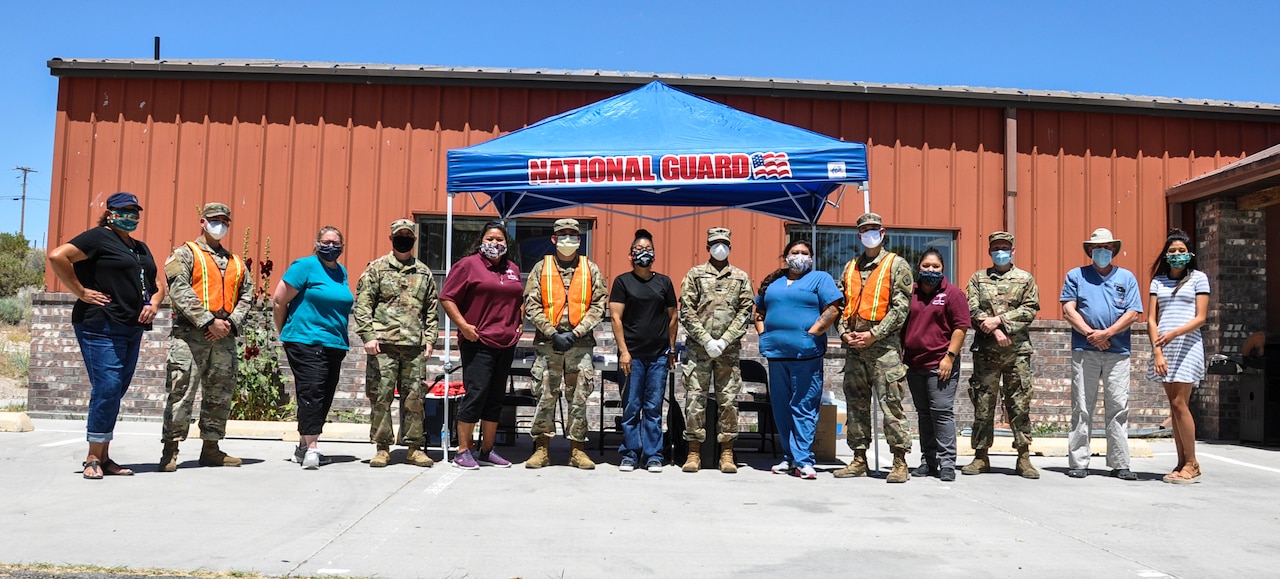
Brenda O’Neil, the health manager for the Duckwater Shoshone Tribal Health Clinic, discussed some of the challenges her people faced the past few months as the pandemic spread throughout the country.
''Any time we leave the reservation, the closest store for supplies is 77 miles away,'' she said. ''Some of those stores were out of basic necessities like bread, flour, sugar and toilet paper. We had to sometimes travel further to cities like Las Vegas or Reno. That would expose us more to the virus.''
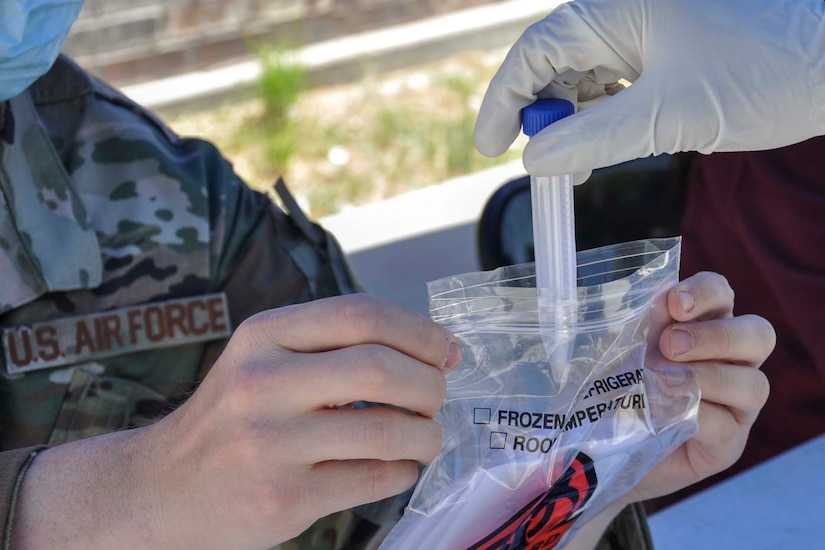
Having to travel hundreds of miles for testing was also a major hurdle for tribe members. The closest hospital with any type of specialty care is in Ely, Nevada. There's a cost associated with transportation, rooms, meals and any other incidentals, O'Neil said, adding that personnel and scheduling, along with the logistical requirements, need to be taken into account when planning medical trips off of tribal land.
''The majority here are elders, and they make up about 60% of our population,'' O'Neil said. ''We didn’t want them leaving the reservation and possibly exposing them to coronavirus.''
COVID-19: Beyond the Uniform
On a blistering hot day in the mountains of Asheville, North Carolina, Army Spc. Enrique Acevedo and Army Pfc. Bennie Kinley, both with the North Carolina Army National Guard, were handing out meals to the children of Buncombe County. Suddenly, a mother from the neighborhood graciously offered ice cream to the two hard-working guardsmen to help cool them down.

This simple scoop of kindness showcased a turning point in the developing relationship between these guardsmen and the local community. It was more than just ice cream. It was an offering and a symbol of established trust.
"It shows the trust and strength between these programs and the communities,"Acevedo said. "They seem to be more accepting that we are just trying to help, … that there is good intention here."
Acevedo and Kinley of the 875th Engineer Company were a part of an eight-member team called up to help the citizens of Asheville. Their service affected the community so much so that it set into motion an unstoppable wave of unity, kindness and friendship during a time of crisis.
"Being an influence on the community just by being who you are makes you a better person," Acevedo said.
At the beginning of their assignment, the guardians in green were met with skepticism and wariness from a community not traditionally exposed to the uniform. To help alleviate the wariness, Acevedo and Kinley took off their uniforms and began distributing food in civilian clothing to show that they were just human beings trying to help.
"It feels really good to go out there and build trust with the communities," Kinley said.
For more than 60 days, the guardsmen have assisted the Mountain Area Nutritional Needs Alliance Foodbank in feeding people in 16 counties and supporting local school food programs.
Western North Carolina is home to diverse communities whose backgrounds originate around the world and who speak a variety of languages. To effectively communicate with the Latino community, these guardsmen broke down language barriers and built relationships of trust.
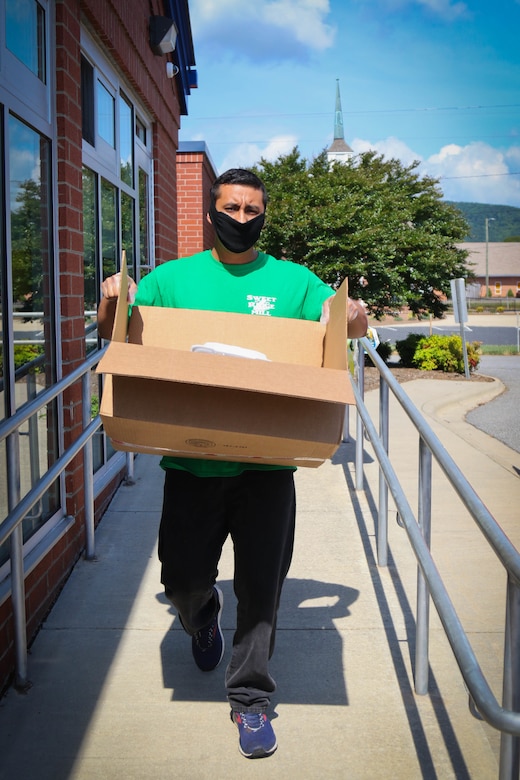
Kinley began to learn Spanish in Army Basic Combat Training to help a fellow trainee, who could not speak English, communicate with her drill sergeants. He continued to enhance his Spanish-speaking capabilities through civilian jobs and friends.
"I chose to learn to understand," Kinley said. "You could still have a friendship through a language barrier, but the more you learn... you gain more of a trust and stronger bond with them."
This experience further encouraged Kinley to learn and communicate with the families they were serving. Acevedo has been a guide in helping Kinley learn the culture and speak Spanish.
Acevedo has been a strong asset to the team due to his background, knowledge and ability to easily connect with the local community. Spanish was Acevedo's first language. He was born in New Jersey, but he was raised in Mexico. His mother eventually returned to the United States to make a better living.
When Acevedo was younger, he and his family often faced struggles from financial insecurity, and he began working at his mother's cleaning service. Due to these hardships, Acevedo knows what it's like to ask for help and receive assistance from programs much like the one he is now working at in Asheville.
"I've been working all my life," Acevedo said. "I understand what these people are going through. I used to be on these programs, so I understand what that means."
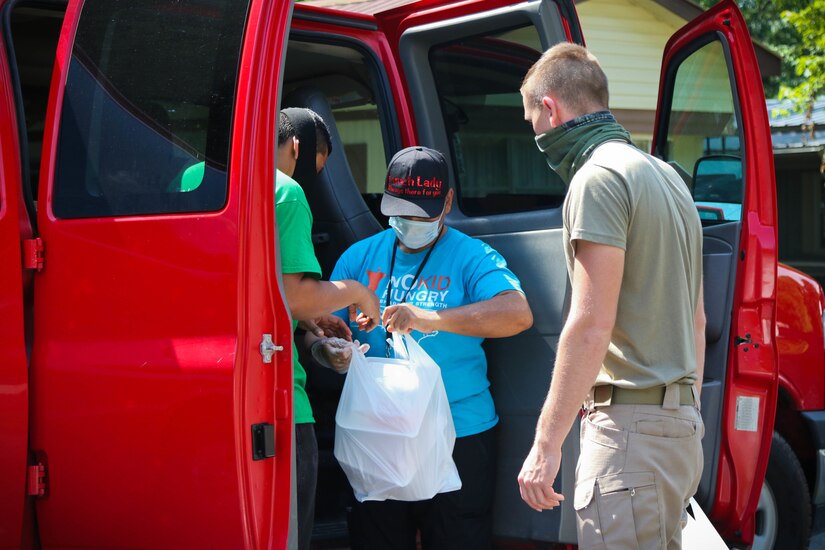
Guardsmen understand that having diversity within the ranks makes a world of difference to the people who are trying to ask for help and communicate their needs. Army Sgt. Jonathan Greene, assigned to the 883rd Engineer Company and the noncommissioned officer in charge for the Ashville emergency relief team, has also made strides in helping the diverse community.
Back home, Greene was a volunteer at a local church that had a chapel for the deaf. The pastor mentored Greene and taught him American Sign Language.
Greene was able to transfer his capabilities and communicate with families in Asheville who were deaf and needed assistance. His unique asset enabled the food bank to effectively understand their needs and provide them the necessary food. "That always stuck with me," Greene said. "Especially handing out food to the families that were deaf."
The eight-member team brought more than just a helping hand. They went beyond their traditional duties to help achieve the joint mission.
"We're making more of a difference," Greene said. "We're helping a community."
(Army Spc. Hannah Tarkelly is assigned to the 382nd Public Affairs Detachment.)
U.S. European Command Force Posture Policy Press Conference: Secretary Esper's Opening Statement (as prepared)
Good morning everyone, and thank you for joining us today. Since being sworn into office more than a year ago, I have been consistent in stating that my top priority would be implementing the National Defense Strategy. Over the past year, we have done just that.
If you look at my recent message to the joint force regarding the progress we’ve made, you’ll see very clearly how far we have moved on our three lines of effort, which include the first line of effort: build a more lethal force; and the second line of effort: strengthen alliances, as well as our 10 subordinate goals.
One important initiative to advance the NDS has been to conduct a review of all the Combatant Commands to ensure a focus on NDS priorities. This includes optimizing our force presence worldwide; directing our time, money, and manpower toward our highest priorities; implementing our Immediate Response Force, Contingency Response Force, and Dynamic Force Employment enhanced readiness concepts; and, moving toward greater use of rotational forces from the United States to enhance our strategic flexibility and operational unpredictability, as we’ve done over the past few months with our Bomber Task Forces. We are pursuing several other initiatives under this rubric as well.
There are currently more than a half dozen Combatant Command reviews underway, beginning with U.S. Africa Command, and the most recent being U.S. Space Command. Today, we want to update you on the status of our U.S. European Command review, which was accelerated with the President’s decision in early June to reduce our footprint in Germany, and our plans to reposition our forces in Europe to be better situated for Great Power Competition.
It is important to note that in NATO’s 71-year history, the size, composition, and disposition of U.S. forces in Europe has changed many times. Sometimes this has been a result of changes in the threat, sometimes because of other changes in the international environment, and sometimes simply because the borders between NATO countries and Russia have shifted as new Allies have joined. As we’ve entered a new era of Great Power Competition, we are now at another one of those inflection points in NATO’s evolution, and I am confident the Alliance will be all the better and stronger for it.
Since June, EUCOM has done excellent work in developing a plan that achieves the President’s objective, and meets the following five principles that I gave General Wolters as he and his staff began their planning:
1. Enhance deterrence of Russia
2. Strengthen NATO
3. Reassure allies
4. Improve U.S. strategic flexibility and EUCOM operational flexibility
5. Take care of our Service members and their families in the process.
The President approved the EUCOM plan in late June; we briefed key members of Congress last week; and the team and I spoke with NATO Secretary General Stoltenberg and directly affected Allies over the past few days. As we share the plan with you, note that this plan is subject to – and likely will – change to some degree, as it evolves over time.
PAUSE
The current EUCOM plan will reposition approximately 11,900 military personnel from Germany – from roughly 36,000 down to 24,000 – in a manner that will strengthen NATO, enhance the deterrence of Russia, and meet the other principles I set forth.
Of the 11,900, nearly 5,600 Service members will be repositioned within NATO countries, and approximately 6,400 will return to the United States, though many of these or similar units will begin conducting rotational deployments back to Europe. The broad strokes of these moves are as follows:
Various U.S. headquarters will be consolidated in locations in Europe outside of Germany, including, in some cases, collocating at the same locations as their NATO counterparts in Belgium and Italy. This will strengthen NATO and improve the operational efficiency and readiness of over 2,000 Service members.
The nearly 4,500 members of the 2nd Cavalry Regiment will return to the United States, as other Stryker units begin continuous rotations farther east in the Black Sea region to enhance deterrence and reassure allies along NATO’s southeastern flank.
The 2,500 airmen based in Mildenhall, United Kingdom, who are responsible for aerial refueling and special operations, and who had been scheduled to re-base to Germany, will remain in the U.K., thus ensuring the uninterrupted readiness and responsiveness of these units.
A fighter squadron and elements of a fighter wing will be repositioned to Italy, moving them closer to the Black Sea region and better capable of conducting dynamic force employments and rotational deployments to NATO’s southeastern flank.
In addition to these moves and the rotational forces announced by President Trump and Polish President Duda in 2019, we also plan on rotating forward the lead element of the Army’s newly established V Corps headquarters to Poland, once Warsaw agrees to a Defense Cooperation Agreement and burden sharing details, as previously pledged.
Our aim is to implement these moves as expeditiously as possible, consistent with the principles I set forth from the beginning, particularly being fair to and taking care of our Service members and their families. We could see some moves begin within weeks; others will take longer.
PAUSE
As anyone can see, the repositioning of our forces in Europe constitutes a major strategic and positive shift, wholly in line with the NDS, and consistent with other adjustments the U.S. has made within NATO in previous times.
These changes will unquestionably achieve the core principles of enhancing U.S. and NATO deterrence of Russia; strengthening NATO; reassuring Allies; and, improving U.S. strategic flexibility and EUCOM operational flexibility.
And, of course, at all times, we will prioritize our most important resource: our Service members and their families. No moves will take place without thorough communication with our people, continued engagement with Congress, and consultation with our Allies.
Thank you, and I will now turn it over to the Vice Chairman of the Joint Chiefs of Staff General Hyten, and EUCOM Commander General Wolters, who will cover these moves in more detail.
Department of Defense Statement: U.S. European Command Force Posture Review
Today the Secretary of Defense announced an update to the status of our U.S. European Command Force Posture review as a part of the department’s continued efforts to implement the National Defense Strategy. Following the decision from the President in early June to reduce our force footprint in Germany, the Secretary provided direction to the Department to develop options for repositioning our forces throughout Europe using five core principles:
- Enhance deterrence of Russia
- Strengthen NATO
- Reassure allies
- Improve U.S. strategic flexibility and EUCOM operational flexibility
- Take care of our Service members and their families in the process
In total, approximately 11,900 military personnel will be repositioned from Germany, with nearly 5,600 repositioned within other NATO countries and 6,400 returning to the United States to address readiness and prepare for rotational deployments.
The plan will consolidate headquarters to strengthen operational efficiency, will reposition some forces to the United States to focus on readiness, and place rotational forces in the Black Sea region on NATO’s southeastern flank. These force posture changes meet the Secretary’s above core principles while adapting our force posture to address national security concerns in today’s environment. In addition, these changes will prioritize service members and their families as they relocate throughout the process.
Read Secretary Esper's opening statement at the U.S. European Command Force Posture Policy press conference.
